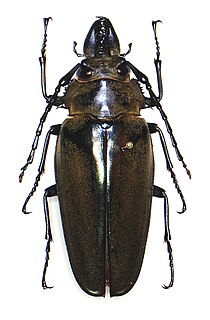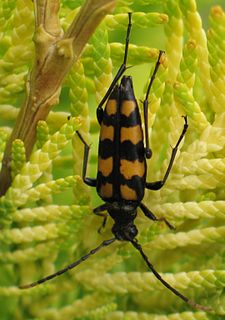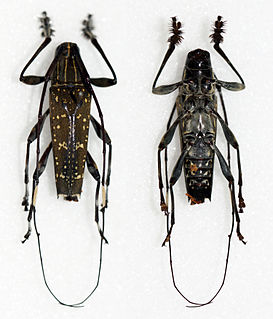
The black-backed woodpecker, also known as the Arctic three-toed woodpecker, is a medium-sized woodpecker inhabiting the forests of North America.

The longhorn beetles (Cerambycidae), also known as long-horned or longicorns, are a large family of beetles, with over 35,000 species described. Most species are characterized by extremely long antennae, which are often as long as or longer than the beetle's body. In various members of the family, however, the antennae are quite short and such species can be difficult to distinguish from related beetle families such as the Chrysomelidae. The scientific name of this beetle family goes back to a figure from Greek mythology: after an argument with nymphs, the shepherd Cerambus was transformed into a large beetle with horns.

The Chrysomeloidea are an enormous superfamily of beetles, with tens of thousands of species, mostly in the families Cerambycidae and Chrysomelidae, the leaf beetles.
Zootaxa is a peer-reviewed scientific mega journal for animal taxonomists. It is published by Magnolia Press. The journal was established by Zhi-Qiang Zhang in 2001 and new issues are published multiple times a week. From 2001 to 2020, more than 60,000 new species have been described in the journal accounting for around 25% of all new taxa indexed in The Zoological Record in the last few years. Print and online versions are available.

Lamiinae, commonly called flat-faced longhorns, are a subfamily of the longhorn beetle family (Cerambycidae). The subfamily includes over 750 genera, rivaled in diversity within the family only by the subfamily Cerambycinae.

The Disteniidae are a small family of beetles in the superfamily Chrysomeloidea, traditionally treated as a group within the Cerambycidae.

The Trictenotomidae are a small family of beetles in the suborder Polyphaga containing fifteen species in two genera. Most species are found in the Oriental realm where they live in montane forest habitats. The family is considered, based on larval characters as well as sequence-based studies, to be closely related to the Salpingidae.

Leptura is a genus of beetles in the family Cerambycidae, containing the following species:
Trachyderini is a tribe of long-horned beetles in the family Cerambycidae. There are at least 140 genera and 650 described species in Trachyderini.

Aegomorphus is a large genus of beetles in the family Cerambycidae.
Grevillea molyneuxii, commonly known as the Wingello grevillea, is a shrub which is endemic to the shrublands of New South Wales in Australia.

Plectromerus dezayasi is a species of beetle in the family Cerambycidae. It was described by Nearns and Branham in 2008.
Syllitus is a genus of long-horned beetles in the family Cerambycidae. There are more than 40 described species in Syllitus.
Callimoxys is a genus of long-horned beetles in the family Cerambycidae. There are about eight described species in Callimoxys.

Colobothea is a genus of longhorn beetles of the subfamily Lamiinae.
Dmytro Zajciw was a Ukrainian and Brazilian entomologist, notable for his collection and for his many beetle discoveries. He was born in Velyka Mykhailivka, Ukraine and died in Rio de Janeiro, Brasil. He was the author of Two new genera and species of neotropical Longhorn beetles , 1957, Contribution to the study of Longhorn beetles of Rio de Janeiro , 1958, and was the first to describe the genera Adesmoides and Pseudogrammopsis, as well as the species Beraba angusticollis and Mionochroma subaurosum, among many others.
Tricondyloides persimilis is a species of beetle in the family Cerambycidae. It was described by Stephan von Breuning in 1939. Its type locality is Mt. St. Arago, New Caledonia.

Macadamia jansenii is an endangered and poisonous tree in the flowering plant family Proteaceae, native to Queensland in Australia. It was only described as a new species in 1991, being first brought to the attention of plant scientists in 1983 by Ray Jansen, a sugarcane farmer and amateur botanist from South Kolan in Central Queensland. Closely related to the cultivated and recently domesticated macadamia nut, it has small 11–16 mm diameter nuts that have a smooth, hard, brown shell enclosing a cream, globulose kernel that is bitter and inedible. In the wild it grows as a multi-stemmed 6–9m tall evergreen tree, with leaves having entire margins and generally in whorls of 3. An extremely rare species, it was discovered as a single population of around 60 plants in the wild in Eastern Australia. In 2018 about 60 new mature Macadamia jansenii trees were located, although a quarter of these were destroyed in the bush fires of 2019.
Podabrocephalus is the only genus in the beetle family Podabrocephalidae, or alternatively, included in the highly diverse family Cerambycidae. Its only species is Podabrocephalus sinuaticollis. It is known from southern India.

Aeolesthes sarta, commonly known as the city longhorn beetle, is a species of beetle in the family Cerambycidae, the longhorn beetles.











